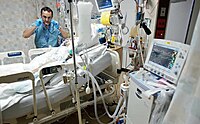
Photo from wikipedia
Background Burnout syndrome (BOS) is a job-related stress disorder featured by three main cardinal manifestations: emotional exhaustion (EE), reduced personal accomplishment (PA), and depersonalization (DP). Aim We aimed to report… Click to show full abstract
Background Burnout syndrome (BOS) is a job-related stress disorder featured by three main cardinal manifestations: emotional exhaustion (EE), reduced personal accomplishment (PA), and depersonalization (DP). Aim We aimed to report the prevalence of burnout and the impact of leadership and work condition on the burnout among respiratory therapists (RT) are front-line practitioners in many critical settings. Methods We surveyed RT in eight intensive care units (ICU) at five tertiary hospitals, under one medical corporation, using three instruments: the Maslach Burnout Inventory Human Services Survey for Medical Personnel, Condition of Work Effectiveness Questionnaire (CWEQ), and Leadership behaviours scale. We used a group of other health care practitioners (ie, physicians and nurses) as the control group. Results Of a sampling frame of 1222 ICU practitioners, 445 (36.4%) responded with completed surveys. Eighty-four (17.3%) and 361 (82.7%) participants were in the RT and the control group, respectively. The overall burnout score was significantly lower in the RT group (53.6% vs. 67%, p = 0.02). The EE and DP scores were significantly lower in the RT group [(26.2% vs. 37.7, p = 0.048) and (9.5% vs. 19.9%, p = 0.025), respectively], but the PA score did not show significant difference between the groups. A significant negative relationship was found between CWEQ score and both EE and DP scores (rs = −0. 0.557, p < 0.001) and (rs = −0.372, p < 0.001), respectively, while a significant positive correlation was found between CWEQ and the PA score (rs = 0.225, p < 0.042). A significant negative relationship was found between the leadership attitude and EE scores (rs = −0.414, p < 0.001). Conclusion The results of this study suggest a high burnout rate among RT. The reported rate was significantly correlated to work conditions and leadership behaviours. Organizational efforts should be directed to combating burnout through the identification and adequate management of the key precipitating factors. ClinicalTrials.gov Identifier: NCT04620005
Journal Title: Journal of Intensive Care Medicine
Year Published: 2022
Link to full text (if available)
Share on Social Media: Sign Up to like & get
recommendations!